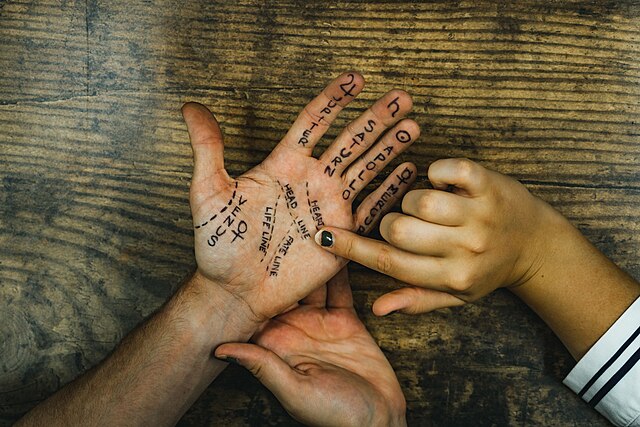Loading AI tools
Foretelling the future through the study of the palm From Wikipedia, the free encyclopedia
Palmistry is the pseudoscientific practice of fortune-telling through the study of the palm. Also known as palm reading, chiromancy, chirology or cheirology, the practice is found all over the world, with numerous cultural variations. Those who practice palmistry are generally called palmists, hand readers, hand analysts, or chirologists.


There are many—and often conflicting—interpretations of various lines and palmar features across various teachings of palmistry. Palmistry is widely viewed as a pseudoscience due to various contradictions between different interpretations and the lack of evidence for palmistry's predictions.[1][2]


Palmistry is a practice common to many different places on the Eurasian landmass;[3] it has been practiced in the cultures of Sumer, Babylonia, Arabia, Canaan, Persia, India, Nepal, Tibet and China.
The acupuncturist Yoshiaki Omura describes its roots in Hindu astrology (known in Sanskrit as jyotish), Chinese Yijing (I Ching), and Roma fortune tellers.[4] Several thousand years ago, the Hindu sage Valmiki is thought[5][better source needed] to have written a book comprising 567 stanzas, the title of which translates in English as The Teachings of Valmiki Maharishi on Male Palmistry.[5][6] Since ancient times, palmistry is considered to be a branch of Samudrika Shastra (Sanskrit: सामुद्रिक शास्त्र) which included the studies of marks all over a person's body such as astrology and palmistry (Hast-samudrika), as well as phrenology (kapal-samudrik) and face reading (physiognomy, mukh-samudrik).[7][8] From India, the art of palmistry spread to China, Tibet and to other countries in Europe.[4][9]
Palmistry also progressed independently in Greece where Anaxagoras practiced it.[4] Aristotle (384–322 B.C.E.) reportedly discovered a treatise on the subject of palmistry on an altar of Hermes, which he then presented to Alexander the Great (356–323 B.C.E.), who took great interest in examining the character of his officers by analyzing the lines on their hands.[10] A chapter of a 17th-century sex manual, misattributed to Aristotle, is occasionally incorrectly cited as being the treatise in question. The text it is not contained in his canonical works.

In Renaissance magic, palmistry (known as "chiromancy") was classified as one of the seven "forbidden arts", along with necromancy, geomancy, aeromancy, pyromancy, hydromancy, and spatulamancy (scapulimancy).[11] During the 16th century the art of palmistry was actively suppressed by the Catholic Church. Both Pope Paul IV and Pope Sixtus V issued papal edicts against various forms of divination, including palmistry.[12]
Palmistry experienced a revival in the modern era starting with Captain Casimir Stanislas D'Arpentigny's publication La Chirognomie in 1839.[9]
The Chirological Society of Great Britain was founded in London by Katharine St. Hill in 1889 with the stated aim to advance and systematise the art of palmistry and to prevent charlatans from abusing the art.[13][14] Edgar de Valcourt-Vermont (Comte C. de Saint-Germain) founded the American Chirological Society in 1897.
A pivotal figure in the modern palmistry movement was the Irish William John Warner, known by his sobriquet, Cheiro. After studying under gurus in India, he set up a palmistry practice in London and enjoyed a wide following of famous clients from around the world, including famous celebrities like Mark Twain, W. T. Stead, Sarah Bernhardt, Mata Hari, Oscar Wilde, Grover Cleveland, Thomas Edison, the Prince of Wales, General Kitchener, William Ewart Gladstone, and Joseph Chamberlain. So popular was Cheiro as a "society palmist" that even those who were not believers in the occult had their hands read by him. The skeptical Mark Twain wrote in Cheiro's visitor's book that he had "exposed my character to me with humiliating accuracy".
Edward Heron-Allen, an English polymath, published various works including the 1883 book, Palmistry: A Manual of Cheirosophy, which is still in print.[9][15] There were attempts at formulating some sort of scientific basis for the art, most notably in the 1900 publication The Laws of Scientific Hand Reading by William Gurney Benham.[16]
In 1970, Parker Brothers published a game designed by Maxine Lucille Fiel called "Touch-Game of Palmistry" which allowed players have "palm reading and analysis" through selecting cards that matched designated palm features.[17]
Scientific literature regards palmistry as a pseudoscientific or superstitious belief.[19] Psychologist and noted skeptic Ray Hyman has written:[20]
I started reading palms in my teens as a way to supplement my income from doing magic and mental shows. When I started I did not believe in palmistry. But I knew that to "sell" it I had to act as if I did. After a few years I became a firm believer in palmistry. One day the late Stanley Jaks, who was a professional mentalist and a man I respected, tactfully suggested that it would make an interesting experiment if I deliberately gave readings opposite to what the lines indicated. I tried this out with a few clients. To my surprise and horror my readings were just as successful as ever. Ever since then I have been interested in the powerful forces that convince us, reader and client alike, that something is so when it really isn't.
Skeptics often include palmists on lists of alleged psychics who practice cold reading. Cold reading is the practice that allows readers of all kinds, including palmists, to appear psychic by using high-probability guessing and inferring details based on signals or cues from the other person.[21][22]
Although some Christians condemn palmistry as a form of divination, Jewish and Christian traditions are largely ambivalent about divination in general.[23] During the 16th century the Catholic Church condemned the practice of palmistry.[12] However, there is a long tradition of practicing palmistry within both Jewish and Christian mysticism,[24] and some practitioners, such as Comte C. de Saint-Germain, have argued that the Bible does not oppose it.[25]
Seamless Wikipedia browsing. On steroids.
Every time you click a link to Wikipedia, Wiktionary or Wikiquote in your browser's search results, it will show the modern Wikiwand interface.
Wikiwand extension is a five stars, simple, with minimum permission required to keep your browsing private, safe and transparent.